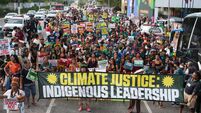Agriculture and the emissions row: how did we get here?

Within the agri-food system, individual farmers not only tend to benefit the least, but also wield the least power; and yet, they continue to be identified as the ones most responsible for climate change. File picture: Andy Gibson
The recent focus on the importance of reducing agricultural emissions has prompted passionate debate on all sides.
There has been a lot of talk about farmers and rural Ireland being scapegoated for necessary action on climate change, but whose interests are actually being protected when farmers and rural Ireland are invoked in these debates?
According to the CSO, 84% of Ireland’s agricultural land is devoted to grass. This is not a natural outcome of our temperate climate and soil type, but the result of Ireland’s colonial history, state policy and economic interests.
With entry into the EEC in 1973, subsidies and market expansion combined to rapidly transform farming practices and rural landscapes. Publicly-funded research bodies and agricultural colleges trained farmers to maximise grass production and select the most productive cattle breeds.
While this expertise was nominally focused on productivity and efficiency in 'the agricultural sector' as a whole, the need to raise national output became a justification for concentrating technological investment on the most ‘progressive’ farmers, who were already those with the most resources.
Entry into the EEC meant new markets for Irish beef and dairy. These European markets were saturated by the 1980s, leading to free trade agreements between the EEC and indebted countries across the Global South where surplus production could be dumped.
International trade policies were coupled with shifts in processing, retailing and marketing, particularly in the dairy sector. Rather than focusing on food production, farming was subordinated to the needs of the processed food and ingredients industry.
Producer Prices for dairy products rose by more than 49% in the year to June 2022https://t.co/V7WY3TaRiT #CSOIreland #Ireland #Wholesaleprices #Prices #Business #BusinessStatistics #IrishBusiness pic.twitter.com/3d2it04XGE
— Central Statistics Office Ireland (@CSOIreland) July 22, 2022
This was largely driven by dairy cooperatives seeking to maintain competitiveness in an era of free trade and liberalisation; profits were in the food industry, not farming. In 1995, the cooperative food industry (primarily dairy processors) recorded a turnover of £6,000 million, compared to £20m in 1970.
Fast forward to today and Ireland accounts for 10% of the global baby formula market, which is 35% of all dairy exports.
The social and ecological costs of this intensive but profitable agri-food system became apparent in the 1990s. Water pollution from excess slurry and fertilisers was reported by the newly established Environmental Protection Agency (EPA) and came under increasing scrutiny from the EU.
And yet, fewer and fewer farmers could make a living, even as revenues for the sector as a whole grew. Between 1984 and 2014, the number of dairy farms decreased from 80,000 to 17,500, while productivity per farm increased by 470%.
A two-tiered agricultural system emerged, in which one class of (dairy) farmers were encouraged to become efficient enterprises, and another class of farmers were forced to diversify into other sectors, including the less-profitable beef sector. This stratification within the farming sector has continued apace since the 1990s.
Successive Irish governments have been adept at treading a line between sustaining and expanding the dominant model of agricultural production, while deflecting and managing the mounting social and ecological costs. The main 'successful' policies - from the point of view of the majority of farmers - came from government departments that had nothing to do with agriculture - namely rural development and social welfare policies.
We need to stop talking about ‘farmers’ and the agricultural sector, and start talking about a globalised agri-food system that is the product of 50 years of Irish and EU policy. These policies in turn are coupled with the hugely profitable activities of agri-businesses, including processors and retailers.
In Ireland, this agri-food system has served a shrinking number of farmers and, mostly, ancillary industries like chemicals, pharmaceuticals, feedstuffs, insurance, banking, machinery, advisory services and agri-food processing and retail.
Within this vast edifice, individual farmers not only tend to benefit the least, but also wield the least power; and yet, they continue to be identified as the ones most responsible for climate change. The majority of farmers in Ireland are not even part of this agri-food system – the one that produces 37% of national emissions.
A 2019 TASC report revealed that the agricultural sector has the most severe inequality in income distribution of any sector in Ireland. Most Irish farmers are, in fact, highly reliant on EU direct payments: the average total payment received in 2017 was €17,672 per farm and this accounted for 75% of average farm income.
Conflating all farmers, or even rural Ireland, with the dominant agri-food system, allows a small minority of powerful interests to claim an authority they should not have. It excludes the many other farmers, and rural inhabitants, who live and work on the land but cannot make a living from it.
It also excludes a growing number of alternative farming and food initiatives that get no media platform at all during these debates.
We need farmers because without them we won’t have food. Proposals to replace farming with environmental schemes have been part of Irish and EU policy since the 1990s. These have not worked because they fail to challenge the economic imperative to intensify production that is central to the globally competitive agri-food system.
Without prioritising alternative local food production, the food we consume in this country will continue to be outsourced to other parts of the world, reliant on labour exploitation, ecological degradation and the growing risks associated with climate change.
Alternative farmer organisations do exist in Ireland. For example, Talamh Beo is a member-based organisation and part of La Via Campesina, the international movement of farmers with more than 180 member organisations in 82 countries.
La Via Campesina and Talamh Beo advocate for policies that put more power, not less, into the hands of farmers, envisioning an alternative agri-food system that prioritises agricultural livelihoods, ecological well-being, and affordable, healthy food, over corporate profits.
Such policies include land reform to allow greater access to land for agro-ecological farming; publicly funded research into agro-ecology and regenerative farming; and measures to support local food supply chains, such as local procurement in public organisations.
As a start, there needs to be more air time given to these policy alternatives and the organisations that are advocating for them.
- Dr Patrick Bresnihan is lecturer in the Department of Geography at Maynooth University
CLIMATE & SUSTAINABILITY HUB

















